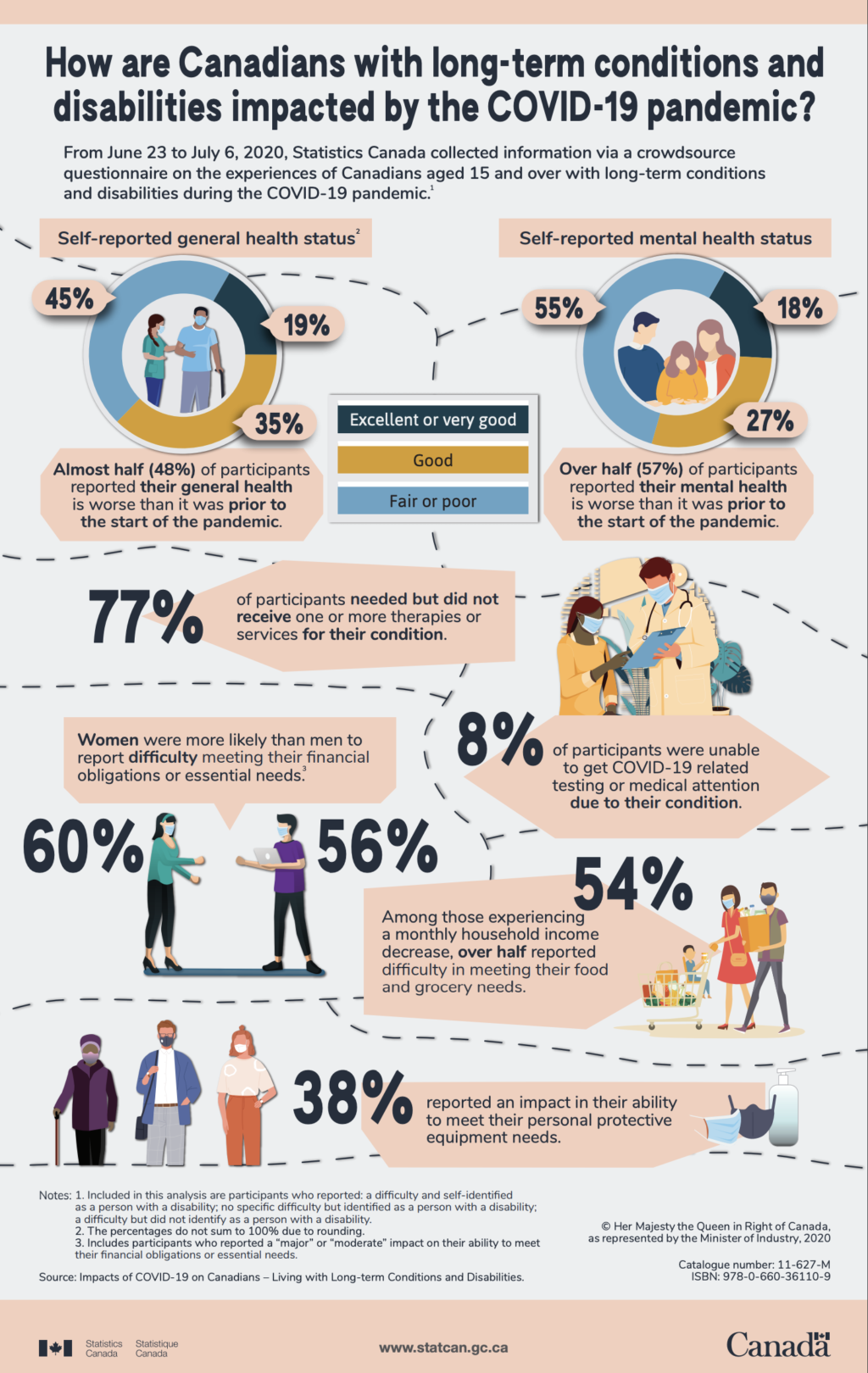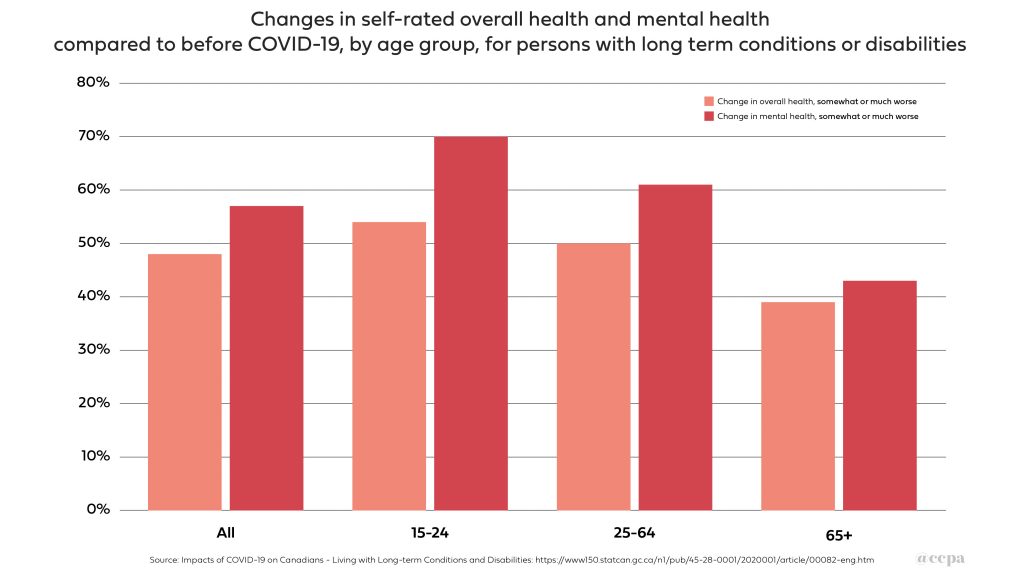People with disabilities last in line October 30th is the day that people with disabilities will begin to receive a one-time payment of $600 in recognition of the significant increase in expenses due to the COVID-19 pandemic. The payout comes a full 14 weeks after authorizing legislation was finally passed following much political wrangling, five months after the financial package was initially announced by the Prime Minister, and more than seven months after governments began issuing state of emergency and stay-at-home orders across Canada.
Once again, people with disabilities are last in line.
The one-time benefit will be welcome for the 1.7 million people targeted to receive it–but that’s a fraction of the 6.2 million adults and 200,000+ children living in Canada who report having one or more disabilities that limit their day-to-day lives.
And it doesn’t begin to compensate for the extraordinary expenses people with disabilities have incurred throughout the pandemic nor for the extraordinary labour now involved in trying to locate scarce PPE, secure support workers in huge demand, nor access needed medical care, safe transportation and workplace accommodation, all part of navigating and surviving in a COVID-19 world.
As low paid workers, people with disabilities–women in particular–have been significantly impacted by employment loss and the collapse in household earnings. One third of participants in a recent Statistics Canada survey reported a decline in household incomes since the start of the shutdown, with over half experiencing a loss of more than $1,000 per month.
Many more are having difficulty meeting their financial obligations and paying for essential needs – especially those from racialized and other marginalized communities. Rates of poverty were already very high among people with disabilities–many of whom are compelled to subsist on welfare benefits that even in the most generous province, Quebec, fall far below the poverty line.
Provincial and territorial governments, for their part, have offered little by way of support. Only three have provided COVID-related income support to people on social assistance. Indeed, most governments partially or fully clawed back CERB benefits from eligible recipients (with the exception of BC, NWT and Yukon). This all amounts to a huge windfall for provincial/territorial governments at the expense of the most vulnerable.
Disability advocates question why disability benefit levels remain so low in the comparison to the $500 per week extended to those facing the loss of employment related to the pandemic under the CERB and the new suite of recovery benefits. “Do our lives count for less?”
Heightened risk of poverty and illness Heightened economic insecurity is just one of the wholly predictable threats to the well-being of people with disabilities during this crisis and beyond. The risk of contracting COVID-19 and experiencing severe illness and death continues to be as large as ever, especially among those living in congregate settings like long term care facilities and group homes.
People with disabilities remain hugely isolated and exposed, having endured months of cancellations and delays in access to care and treatment, unable to rely on the support of family, friends and community services. Across the country, people with disabilities are still subject to medical triage protocols that threaten their very right to health care and life itself.
New research out from Statistics Canada today confirms that almost half (48%) of respondents in a survey of people with long-term conditions or disabilities reported that their health was ‘much worse’ or ‘somewhat worse’ since before the pandemic, while more than half (57%) stated that the state of their mental health had deteriorated as well.
A few weeks into the pandemic, the Australian government rolled out an emergency response plan “to minimise the spread of COVID-19” and related illness and/or death among people with disabilities and to “ensure fair access to health care during the viral outbreak.”
In Canada, the response has been, in the words of federal Minister Carla Qualtrough, “embarrassingly hard” and has “taken way too long.”
Canadian Disability Benefit: Will it deliver? Last month’s Speech from the Throne signalled a more comprehensive response is on the way. The federal government will be introducing a Disability Inclusion Plan that includes a new Canadian Disability Benefit (CDB) modelled on the Guaranteed Income Supplement (GIS) for seniors, a “robust employment strategy” for people with disabilities and a better process for determining eligibility for benefits and programs.
A new disability benefit could reduce the numbers of those living in deep poverty and improve the health and well-being of millions. But, this all hinges on what comes next: the program details, eligibility criteria, related funding commitments, proposed timeline, and quality of engagement with the community.
The GIS is a monthly non-taxable benefit of up to $11,000/year paid to low-income seniors who are already eligible for Old Age Security benefits. Is the goal of the new CDB, then, to supplement income from other sources? Will it replace some or all of the other benefit programs available to people with disabilities such as social assistance, workers’ compensation, CPP-Disability, veteran’s disability benefits? Will it be set at a level that provides for a life of dignity and personal autonomy?
Will it include an earnings exemption or clawback on other sources of taxable income as the GIS does? Will there be a Canadian residency rule of at least 10 years–as the GIS includes? Will it establish a more comprehensive definition of disability than the highly targeted criteria used to access the Disability Tax Credit which screens out hundreds of thousands of potential recipients and is a source of profound systemic discrimination.
As critically, how will the Canadian Disability Benefit impact eligibility for other federal, provincial and territorial support and services such as access to, for example, subsidized housing, public drug funding programs, and training programs? The experience with CERB is more than a cautionary tale. Those living in rent geared to income housing saw their rents shoot up by as much as $600 per month when the first CERB cheque came in.
As John Stapleton writes, we can only hope that the new benefit “doesn’t look too much like GIS.” What we need is a Canada-wide income guarantee or floor for people with disabilities that, in combination with personal supports and community services, lifts people out of poverty.
Disability Inclusion Plan The pandemic crisis has highlighted the urgent need for structural re-think and systemic change. Too many people with disabilities are falling through the gaping holes in our social safety net. All governments need to step up with programs that can meet the immediate needs of millions and lay the foundation for a safer, more inclusive and just future in the weeks, months and years to come.
It’s impossible to talk about what a Disability Inclusion Plan should involve without centring the perspectives of people with disabilities and acknowledging the intersectional nature of ongoing discrimination. The voices of people with disabilities are almost completely invisible in policy and research. This includes women and girls, First Nations, Inuit and Métis (FNIM) peoples, deaf* and hearing impaired, those with invisible and less-understood disabilities, episodic and chronic disabilities and intellectual and neurological disabilities.
We need to bring a disability lens to all planning and action for the recovery and support the leadership of people with disabilities in all of our recovery efforts.
All funding agreements, for example, with provinces and territories, municipalities, and FNIM communities to build out physical and social infrastructure should be designed to achieve a broad range of policy objectives–with a view to prioritizing the needs of people with disabilities. This includes projects in neglected but critically important service areas (e.g., bringing buildings up to accessibility standards, investing in the care economy, expanding health/education/community supports, etc.) and increasing the stock of supported and affordable housing.
A Disability Inclusion Plan should also set targets for employing people with disabilities in this work and providing opportunities for education/training as well as community leadership. Employment equity has been an important policy objective for years. All governments have a leadership role to play in setting out standards for disability-inclusive workplaces and making sure that their own labour force is representative and accessible to all.
This is also the opportunity to strengthen and harmonize the institutions and processes tasked with upholding human rights and monitoring our collective efforts to dismantle the systemic legacies of exclusion and ableism, ensuring that no one is left behind.
What’s needed now is a heightened sense of urgency to move the promise of this Speech from the Throne into the transformative action required to realize disability justice.
*We recognize that not all deaf people identify as disabled.
Katherine Scott is a Senior Economist with the Canadian Centre for Policy Alternatives. Follow her on Twitter @ScottKatherineJ.








